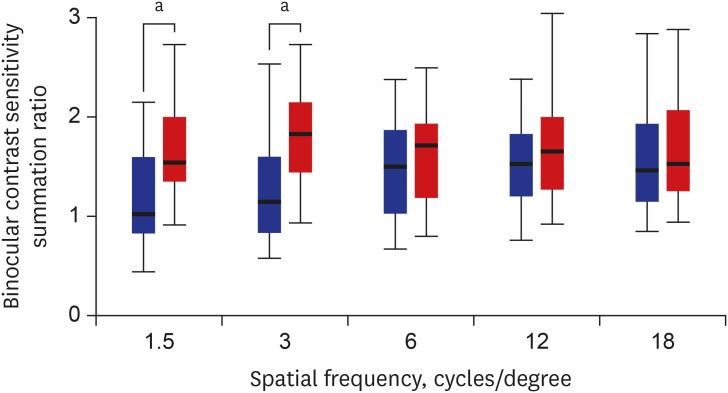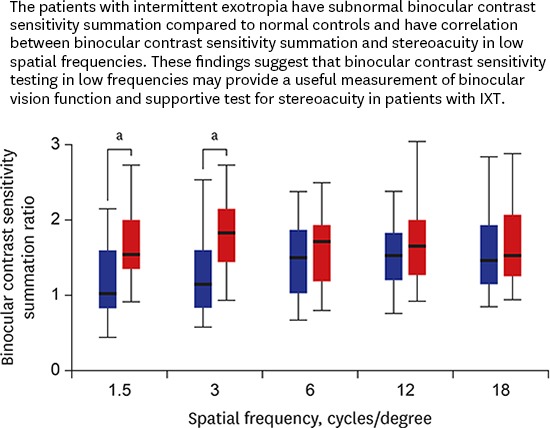1. Mohney BG, Huffaker RK. Common forms of childhood exotropia. Ophthalmology. 2003; 110(11):2093–2096. PMID:
14597514.
2. Jampolsky A. Differential diagnostic characteristics of intermittent exotropia and true exophoria. Am Orthopt J. 1954; 4(1):48–55. PMID:
13180847.
3. Brodsky MC, Jung J. Intermittent exotropia and accommodative esotropia: distinct disorders or two ends of a spectrum? Ophthalmology. 2015; 122(8):1543–1546. PMID:
26210597.
4. Romanchuk KG, Dotchin SA, Zurevinsky J. The natural history of surgically untreated intermittent exotropia-looking into the distant future. J AAPOS. 2006; 10(3):225–231. PMID:
16814175.
5. Holmes JM, Leske DA, Hatt SR, Brodsky MC, Mohney BG. Stability of near stereoacuity in childhood intermittent exotropia. J AAPOS. 2011; 15(5):462–467. PMID:
22108358.
6. Hatt SR, Mohney BG, Leske DA, Holmes JM. Variability of stereoacuity in intermittent exotropia. Am J Ophthalmol. 2008; 145(3):556–561. PMID:
18201680.
7. Stathacopoulos RA, Rosenbaum AL, Zanoni D, Stager DR, McCall LC, Ziffer AJ, et al. Distance stereoacuity. Assessing control in intermittent exotropia. Ophthalmology. 1993; 100(4):495–500. PMID:
8479706.
8. Mohney BG, Holmes JM. An office-based scale for assessing control in intermittent exotropia. Strabismus. 2006; 14(3):147–150. PMID:
16950743.
9. Yulek F, Velez FG, Isenberg SJ, Demer JL, Pineles SL. Binocular summation and control of intermittent exotropia. Strabismus. 2017; 25(2):81–86. PMID:
28481654.
10. Nishikawa N, Ishiko S, Yamaga I, Sato M, Yoshida A. Distance stereotesting using vision test charts for intermittent exotropia. Clin Ophthalmol. 2015; 9:1557–1562. PMID:
26346264.
11. Hatt SR, Leske DA, Liebermann L, Holmes JM. Quantifying variability in the measurement of control in intermittent exotropia. J AAPOS. 2015; 19(1):33–37. PMID:
25727584.
12. Lema SA, Blake R. Binocular summation in normal and stereoblind humans. Vision Res. 1977; 17(6):691–695. PMID:
602028.
13. Chung ST, Legge GE. Comparing the shape of contrast sensitivity functions for normal and low vision. Invest Ophthalmol Vis Sci. 2016; 57(1):198–207. PMID:
26795826.
14. Pardhan S, Gilchrist J. Binocular contrast summation and inhibition in amblyopia. The influence of the interocular difference on binocular contrast sensitivity. Doc Ophthalmol. 1992; 82(3):239–248. PMID:
1303860.
15. Pelli DG, Bex P. Measuring contrast sensitivity. Vision Res. 2013; 90:10–14. PMID:
23643905.
16. Legge GE. Binocular contrast summation--I. Detection and discrimination. Vision Res. 1984; 24(4):373–383. PMID:
6740958.
17. Howland B, Ginsburg A, Campbell F. High-pass spatial frequency letters as clinical optotypes. Vision Res. 1978; 18(8):1063–1066. PMID:
706157.
18. Leske DA, Holmes JM. Maximum angle of horizontal strabismus consistent with true stereopsis. J AAPOS. 2004; 8(1):28–34. PMID:
14970796.
19. Birch E, Williams C, Hunter J, Lapa MC. Random dot stereoacuity of preschool children. ALSPAC “Children in Focus” Study Team. J Pediatr Ophthalmol Strabismus. 1997; 34(4):217–222. PMID:
9253735.
20. Kattan JM, Velez FG, Demer JL, Pineles SL. Relationship between binocular summation and stereoacuity after strabismus surgery. Am J Ophthalmol. 2016; 165(2):29–32. PMID:
26921805.
21. Legge GE. Binocular contrast summation--II. Quadratic summation. Vision Res. 1984; 24(4):385–394. PMID:
6740959.
22. Blake R, Wilson H. Binocular vision. Vision Res. 2011; 51(7):754–770. PMID:
20951722.
23. Pineles SL, Demer JL, Isenberg SJ, Birch EE, Velez FG. Improvement in binocular summation after strabismus surgery. JAMA Ophthalmol. 2015; 133(3):326–332. PMID:
25555109.
24. Campbell FW, Green DG. Monocular versus binocular visual acuity. Nature. 1965; 208(5006):191–192. PMID:
5884255.
25. Carmel D, Arcaro M, Kastner S, Hasson U. How to create and use binocular rivalry. J Vis Exp. 2010; (45):1–10. PMID:
20164822.
26. Pineles SL, Velez FG, Isenberg SJ, Fenoglio Z, Birch E, Nusinowitz S, et al. Functional burden of strabismus: decreased binocular summation and binocular inhibition. JAMA Ophthalmol. 2013; 131(11):1413–1419. PMID:
24052160.
27. Amigo G, Fiorentini A, Pirchio M, Spinelli D. Binocular vision tested with visual evoked potentials in children and infants. Invest Ophthalmol Vis Sci. 1978; 17(9):910–915. PMID:
700970.
28. Cheng A, Eysel UT, Vidyasagar TR. The role of the magnocellular pathway in serial deployment of visual attention. Eur J Neurosci. 2004; 20(8):2188–2192. PMID:
15450098.
29. Poggio GF, Poggio T. The analysis of stereopsis. Annu Rev Neurosci. 1984; 7(1):379–412. PMID:
6370081.
30. Ingling CR Jr, Grigsby SS. Perceptual correlates of magnocellular and parvocellular channels: seeing form and depth in afterimages. Vision Res. 1990; 30(6):823–828. PMID:
2385923.
31. Haggerty H, Richardson S, Hrisos S, Strong NP, Clarke MP. The Newcastle Control Score: a new method of grading the severity of intermittent distance exotropia. Br J Ophthalmol. 2004; 88(2):233–235. PMID:
14736781.
32. Holmes JM, Birch EE, Leske DA, Fu VL, Mohney BG. New tests of distance stereoacuity and their role in evaluating intermittent exotropia. Ophthalmology. 2007; 114(6):1215–1220. PMID:
17241665.
33. Pardhan S, Gilchrist J, Douthwaite W, Yap M. Binocular inhibition: psychophysical and electrophysiological evidence. Optom Vis Sci. 1990; 67(9):688–691. PMID:
2234828.
34. Pineles SL, Birch EE, Talman LS, Sackel DJ, Frohman EM, Calabresi PA, et al. One eye or two: a comparison of binocular and monocular low-contrast acuity testing in multiple sclerosis. Am J Ophthalmol. 2011; 152(1):133–140. PMID:
21570055.
35. Jiménez JR, Ponce A, Anera RG. Induced aniseikonia diminishes binocular contrast sensitivity and binocular summation. Optom Vis Sci. 2004; 81(7):559–562. PMID:
15252357.
36. Chen Z, Li J, Thompson B, Deng D, Yuan J, Chan L, et al. The effect of Bangerter filters on binocular function in observers with amblyopia. Invest Ophthalmol Vis Sci. 2014; 56(1):139–149. PMID:
25352120.
37. Smith EL 3rd, Levi DM, Manny RE, Harwerth RS, White JM. The relationship between binocular rivalry and strabismic suppression. Invest Ophthalmol Vis Sci. 1985; 26(1):80–87. PMID:
3967958.
38. Hess RF, Howell ER. The threshold contrast sensitivity function in strabismic amblyopia: evidence for a two type classification. Vision Res. 1977; 17(9):1049–1055. PMID:
595414.









 PDF
PDF Citation
Citation Print
Print




 XML Download
XML Download